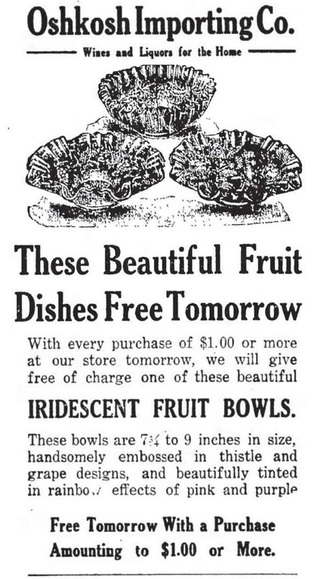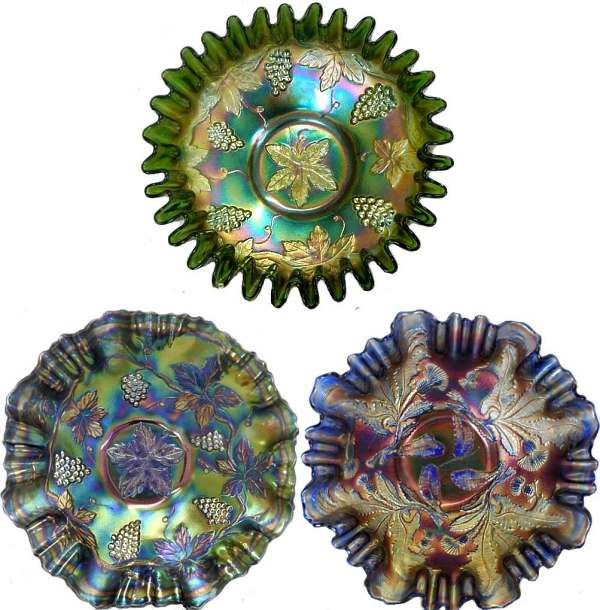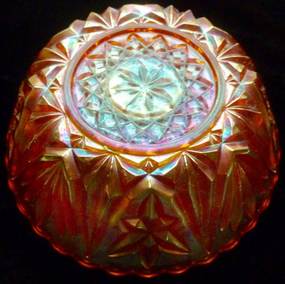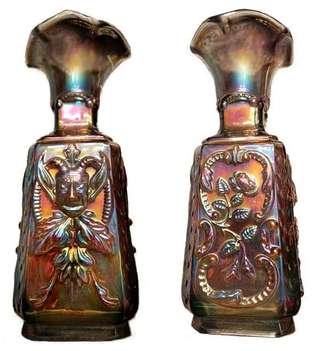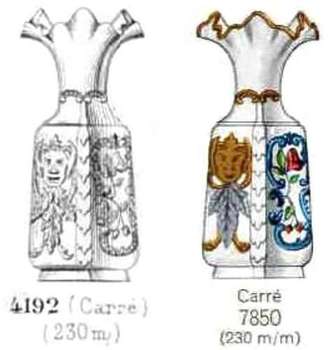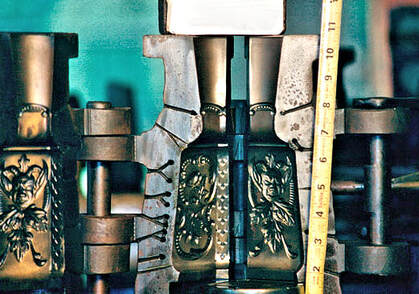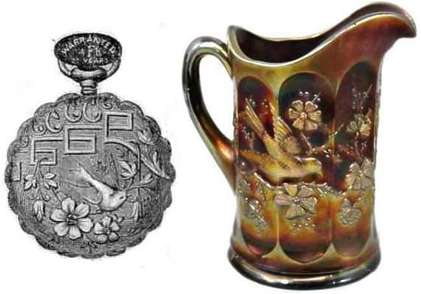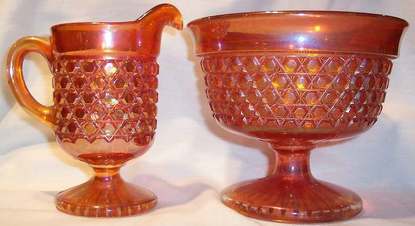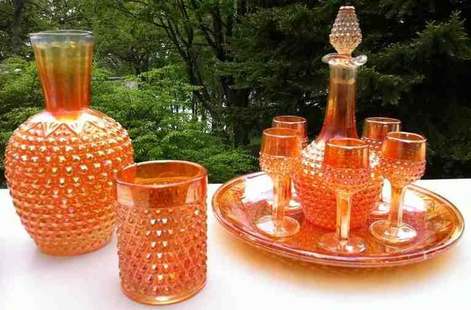NetworK ezine Issue 16. September 2016
Totally Devoted to Carnival Glass
B’Gosh … Carnival from Oshkosh
Surely it's the stuff of dreams.
Any one of these Carnival Glass bowls can be yours simply by spending one dollar at Oshkosh Importing Company in Wisconsin, USA. Despite the "Importing" bit in the company's name, these are entirely home-produced items from Fenton - Vintage and Thistle.
Just one small problem - it was back in 1911.
Here is the ad in the “Wisconsin Daily Northwestern” newspaper from 1911, featuring Carnival Glass bowls offered free by the Oshkosh Importing Co. The colour of the bowls was not given, although they were described as having “tinted rainbow effects of pink and purple”.
Surely it's the stuff of dreams.
Any one of these Carnival Glass bowls can be yours simply by spending one dollar at Oshkosh Importing Company in Wisconsin, USA. Despite the "Importing" bit in the company's name, these are entirely home-produced items from Fenton - Vintage and Thistle.
Just one small problem - it was back in 1911.
Here is the ad in the “Wisconsin Daily Northwestern” newspaper from 1911, featuring Carnival Glass bowls offered free by the Oshkosh Importing Co. The colour of the bowls was not given, although they were described as having “tinted rainbow effects of pink and purple”.
As the heading on the ad suggests, Oshkosh's main line of business was "Wine and Liquors for the Home". Another of their ads offered customers a discrete “plain package” for their wine and liquor purchases.” A couple of bottles of Duffy’s Malt Whiskey at 87 cents apiece would have easily earned a free Fenton bowl and the added promise that the whiskey was "For Medicinal Use". Sure!
Oshkosh Importing Co.was located at 39 Main Street in Oshkosh, Wisconsin (known as the Sawdust City for its long history of the lumber trade). It’s fascinating to think of these beautiful Carnival bowls being offered as an inducement to purchase liquor. And just look at the splendid drawings in the newspaper ad: the candy ribbon and three-in-one edges have been drawn so faithfully.
Read the full fascinating story of Carnival From Oshkosh - it's the latest of our features that use authentic, old ads and newspaper reports to show how Carnival Glass was originally marketed and sold to the buying public of the time.
* A word about Edges
Candy Ribbon Edge is also known as Fine Crimped Edge, Tight Crimped Edge and Continuous Crimping.
Three-in-One Edge (3 in 1), is also known as Fruit Crimp. Frank Fenton preferred to use the term "Two and One" to describe it.
One of the characteristics that makes Carnival Glass so attractive to collectors is the way that the glassmakers used techniques to make each piece look individual. One technique was to shape the bowls to make them distinctly different - as these three bowls show. They are all Fenton's Holly and they are all blue, but the edge treatment gives each of them a very unique appearance. It was very clever, and made far better economic use of the (expensive) moulds.
Oshkosh Importing Co.was located at 39 Main Street in Oshkosh, Wisconsin (known as the Sawdust City for its long history of the lumber trade). It’s fascinating to think of these beautiful Carnival bowls being offered as an inducement to purchase liquor. And just look at the splendid drawings in the newspaper ad: the candy ribbon and three-in-one edges have been drawn so faithfully.
Read the full fascinating story of Carnival From Oshkosh - it's the latest of our features that use authentic, old ads and newspaper reports to show how Carnival Glass was originally marketed and sold to the buying public of the time.
* A word about Edges
Candy Ribbon Edge is also known as Fine Crimped Edge, Tight Crimped Edge and Continuous Crimping.
Three-in-One Edge (3 in 1), is also known as Fruit Crimp. Frank Fenton preferred to use the term "Two and One" to describe it.
One of the characteristics that makes Carnival Glass so attractive to collectors is the way that the glassmakers used techniques to make each piece look individual. One technique was to shape the bowls to make them distinctly different - as these three bowls show. They are all Fenton's Holly and they are all blue, but the edge treatment gives each of them a very unique appearance. It was very clever, and made far better economic use of the (expensive) moulds.
Above: three Fenton Holly bowls with very different edge treatment.
Left to right: ruffled, three-in-one, and candy ribbon. Pictures courtesy of Seeck Auctions.
Left to right: ruffled, three-in-one, and candy ribbon. Pictures courtesy of Seeck Auctions.
Riddles Solved
|
Unravelling Carnival Glass mysteries is a satisfying experience. And we were thrilled when we were able to provide an answer to some long-standing puzzle pieces, with an attribution to a little-known English Carnival Glass maker. Our friend, Dan Ruth from New York, recently found this unusual marigold bowl. It has beautiful iridescence which Dan eloquently describes as “super-thick and smooth satin”. Picture courtesy of Dan Ruth. What is it and who made it? Click on Dan's picture on the right to see all the answers. |
What a Drama!
Imperial produced this distinctive square-sided vase in Rubigold (marigold) and Peacock (smoke) in the 1960s to early 70s, and in Azure Blue (an ice blue colour) in 1969/70. The Imperial pattern number was 486 and the item was listed as 8½” Drama vase (aka Masque). The Drama vase had previously been made by Imperial (non-iridised), in cased glass from 1951, as well as in black suede and black/gold glass c.1953.
The splendid Carnival example illustrated here, below left, is shown courtesy of Carol Sommers (thank you for the pictures, Carol).
|
Now take a look at the two catalogue images above, on the right. They are from the French glass maker, Portieux – the date of the catalogue is 1886. The coloured image indicates that the glass was enamelled, and note it had a different number for ordering that version. The word “carré” means square. The size, 230mm, indicates it was around 8 or 9 inches high (depending on the top shaping and flaring). We have no proof that the splendid Imperial Drama vase was made using either the 1886 Portieux mould or whether Imperial made a new mould. Whatever the case, the Portieux influence is unmistakable. The Drama vase mould came to light again very recently, when Fenton closed and sold their extensive stock of moulds: in the sale list, we discovered it! Over time, Fenton had bought lots of moulds from other companies, including many from Imperial, but as far as we know, Fenton never actually put the Drama vase into production. |
Above: Imperial's mould for the Drama vase
(courtesy of the Fenton Family and Fenton Art Glass Co.) |
Watch the Birdie
Watch the Birdie
|
We were browsing the Sears Roebuck 1898 catalogue (as you do) when we spotted this watch case, far left, with a bird and floral design. We couldn’t help noticing the similarity to Northwood’s Singing Birds design. Can’t you just imagine Harry Northwood having a watch case like this; then perhaps glancing at it one day when checking to see if he would be late for dinner, and wondering to himself: "this would make an attractive design for my iridescent glass" Singing Birds purple water pitcher courtesy Seeck Auctions. |
Spot the Difference
Spot the Difference
Here’s our rough and ready guide to identify the two patterns.
On Brockwitz Miniature Hobnail, the hobs are round and protruding – on Sowerby’s Crosshatch they are angular, 6-sided and flat topped.
If you have a creamer or a sugar bowl (usually stemmed but possibly flat based) it’s most likely Crosshatch. Shapes known for Miniature Hobnail are decanter, wines, tray, tumble-up, and cookie jar.
On Brockwitz Miniature Hobnail, the hobs are round and protruding – on Sowerby’s Crosshatch they are angular, 6-sided and flat topped.
If you have a creamer or a sugar bowl (usually stemmed but possibly flat based) it’s most likely Crosshatch. Shapes known for Miniature Hobnail are decanter, wines, tray, tumble-up, and cookie jar.
Feedback on the Gnome Toothpick Holder (Network #15)
Karen Rath wrote an interesting response to us regarding the Gnome toothpick shown in NetworK #15. She says: “I was caught by your article on this little novelty item. I actually own one that I found in Brazil about seven and a half years ago. I called it Gnome toothpick holder, as the opening would be for a pretty small egg. Mine is also very dark in colour.
Congratulations to Karen on having one of these little beauties! See Corcunda in our unique Collectors Facts series.
Feedback on the Gnome Toothpick Holder (Network #15)
Karen Rath wrote an interesting response to us regarding the Gnome toothpick shown in NetworK #15. She says: “I was caught by your article on this little novelty item. I actually own one that I found in Brazil about seven and a half years ago. I called it Gnome toothpick holder, as the opening would be for a pretty small egg. Mine is also very dark in colour.
Congratulations to Karen on having one of these little beauties! See Corcunda in our unique Collectors Facts series.

